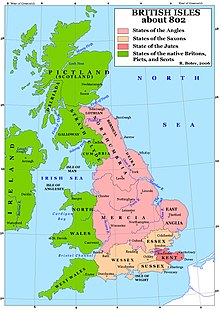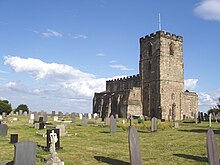Eardwulf (Northumbria)
Eardwulf (also Eardulf, Eardulfus, Earduulfus, Ardulfus, Ardwulfus, St. Hardulph etc .; † around 810 or around 830) was king of the Anglo-Saxon kingdom of Northumbria from 796 until his death . He spent the period from 806 to 808, relieved of his office, in exile. He is considered a saint .
Life
family
Nothing more is known about Eardwulf's origin than that his father was also called Eardwulf or Earnwulf. Possibly he came from Eadwulf (705-706) from the Northumbrian royal family.
Alkuin criticized that he cast his wife soon after his coronation (796) and lived with a concubine. During his exile from 806 to 808, Eardwulf allegedly married an illegitimate daughter of Charlemagne . With his first wife he had the son Eanred .
Early years
He is first mentioned as Ealdorman in 790, when King Æthelred I (774-778 / 779 and 790-796) had him captured. Eardwulf was to be executed in Ripon at the gates of the monastery. The monks took the apparently lifeless body to a tent in front of the church. In the night they found him alive. This “miracle”, to which Alcuin also refers in a letter to Eardwulf, was probably the reason for his later veneration as a saint. Eardwulf left Northumbria and went into exile.
Domination
Succession to the throne
King Æthelred fell victim to a conspiracy of the Ealdormen Ealdred and Wada on April 18, 796 in Cobre ( Corbridge ). Osbald was made his successor, presumably by the conspirators. After just 27 days he was deposed and had to flee. First he found asylum in the Lindisfarne monastery . A little later he fled with some monks by ship to the Picts , whose king Caustantín mac Fergusa (around 789-820) granted him refuge.
His successor Eardwulf returned from exile and ascended the throne on May 14th. He was crowned on May 26, 796 in York by Archbishop Eanbald I (around 780-796) and the bishops Æthelberht of Hexham (789-797), Higbald of Lindisfarne (780-803) and Baldwulf of Whithorn (791-803) .
Power struggles
Eardwulf's early years as king were marked by civil unrest. The Ealdorman Wada, who had joined the murderers of King Æthelred of Northumbria, led a revolt against Eardwulf in 798, possibly supported by Osbald. In the battle of Billingahoth (Billington Moor) near Walalege ( Whalley in Lancashire ), which was costly for both sides , Eardwulf defeated the rebels on April 2 and initially restored royal power. In 799 Eardwulf had the Ealdorman "Moll" executed, who was probably a descendant of the former king Æthelwald Moll (759-765). He had an ambivalent relationship with the church. Archbishop Eanbald II (796 – around 808) of York granted Eardwulf's enemies asylum and appropriated some lands, whereas Eardwulf finally took military action. The monasteries in Ripon and Hexham, however, appear to have supported Eardwulf.
Alcmund , who was murdered by the Eardwulf guards in 800, was allegedly a son of the former King Ealchred (765–774). Alcmund was buried in Derby and venerated as a saint. The burial in Mercia indicates an interference of Cenwulfs (796-821) of Mercia in the Northumbrian politics. After King Cenwulf accepted Northumbrian exiles at his court, King Eardwulf invaded Mercia in 801. However, through the mediation of English bishops, a mutually acceptable peace agreement was concluded.
exile
In 806, according to other sources possibly not until 808, Eardwulf was expelled from Northumbria. Possibly Cenwulf of Mercia was pulling the strings in the background again. Ælfwald II , about whom almost nothing is known, usurped the throne. Eardwulf fled to Nijmegen to the court of Charlemagne, with whom he formed an alliance. In 808 he went to Rome to get the support of Pope Leo III. to secure.
Second term
Eardwulf's second term in office is very uncertain. The list of kings of this century is extremely unclear and so Eanred , the son of Eardwulf, could have been Ælfwald's successor. Other historians, such as B. Simon Keynes think a second term is possible, while Kirby and Rollason in particular believe that Eardwulf actually reigned a second time as King of Northumbria.
Eardwulf returned to Northumbria in the year 808 accompanied by the deacon Aldulfus and the abbots Hruotfridus and Nantharius, and through the intervention of the Frankish ambassadors came back to the throne. King Eardwulf's later life has not been recorded; even the date of his death is uncertain and is put around 810 or 830. According to Roger von Wendover , a 13th century chronicler , his son Eanred succeeded the throne in 810 and ruled until 840/841. On the basis of coin finds by Eanred, which for stylistic reasons was dated to around 850, Rollason takes the view that Eardwulf ruled until around 830, which also shifts the reigns of the later kings of Northumbria . Eardwulf was buried in the monastery of Breedon on the Hill, Leicestershire , where the Church of St Mary and St Hardulph was consecrated to him.
swell
- Symeon of Durham : De Gestis Regum Anglorum (Deeds of the English Kings)
- Symeon of Durham: Historia ecclesiae Dunelmensis (History of the Church of Durham)
- anonymous: Anglo-Saxon Chronicle Online in Project Gutenberg (English)
- Alcuin : Epistolae (letters)
- anonymous: Annales regni Francorum Online at Wikisource (Latin.)
literature
- Barbara Yorke : Kings and Kingdoms of Early Anglo-Saxon England . Routledge, London-New York 2002, ISBN 978-0-415-16639-3 . PDF (6.2 MB)
- Joanna Story: Carolingian Connections: Anglo-Saxon England and Carolingian Francia, c. 750-870 . Ashgate, 2003, ISBN 978-0-7546-0124-1 .
- DP Kirby: The Earliest English Kings . Routledge, London-New York 2000, ISBN 978-0415242110 .
- DP Kirby: Saint Wilfrid at Hexham . Taylor & Francis, 1974, ISBN 0-85362-155-1 .
- David W. Rollason: Northumbria, 500-1100: Creation and Destruction of a Kingdom . Cambridge University Press, 2003, ISBN 978-0521813358 .
Web links
- David W. Rollason: Eardwulf (paid registration required). In: Oxford Dictionary of National Biography , Oxford University Press, 2004. Retrieved February 4, 2012
- Eardwulf 4 in Prosopography of Anglo-Saxon England (PASE)
- Eardwulf in Foundation for Medieval Genealogy
Individual evidence
- ↑ a b c d Simon Keynes: Kings of the Northumbrians . In: Lapidge et al. (Ed.): The Blackwell Encyclopaedia of Anglo-Saxon England . Wiley-Blackwell, Oxford et al. a. 2001, ISBN 978-0-6312-2492-1 , pp. 502-505.
- ↑ a b c d e f g h i j k l m n o p q r s David W. Rollason: Eardwulf ( Memento of the original from December 9, 2012 in the Internet Archive ) Info: The archive link was automatically inserted and not yet checked . Please check the original and archive link according to the instructions and then remove this notice. (paid registration required). In: Oxford Dictionary of National Biography , Oxford University Press, 2004. Retrieved February 4, 2012
- ↑ Melrose Chronicle
- ^ Barbara Yorke: Kings and Kingdoms of Early Anglo-Saxon England . Routledge, London-New York 2002, ISBN 978-0-415-16639-3 , p. 89.
- ^ A b c d Barbara Yorke: Kings and Kingdoms of Early Anglo-Saxon England . Routledge, London-New York 2002, ISBN 978-0-415-16639-3 , p. 95.
- ^ Symeon of Durham: Historia ecclesiae Dunelmensis , 20
- ↑ Symeon of Durham: De Gestis Regum Anglorum for the year 790
- ^ David W. Rollason: Northumbria, 500-1100: Creation and Destruction of a Kingdom . Cambridge University Press, 2003, ISBN 978-0521813358 , p. 194.
- ^ Symeon of Durham: De Gestis Regum Anglorum for the year 799
- ↑ David W. Rollason: Osbald ( Memento of the original of May 22, 2010 in the Internet Archive ) Info: The archive link was automatically inserted and not yet checked. Please check the original and archive link according to the instructions and then remove this notice. (paid registration required). In: Oxford Dictionary of National Biography , Oxford University Press, 2004. Retrieved February 4, 2012
- ^ Anglo-Saxon Chronicle for the year 795
- ^ Symeon of Durham: De Gestis Regum Anglorum for the year 798
- ↑ DP Kirby: Saint Wilfrid at Hexham . Taylor & Francis, 1974, ISBN 0-85362-155-1 , p. 26.
- ^ A b Symeon of Durham: De Gestis Regum Anglorum for the year 800
- ↑ Anglo-Saxon Chronicle for the year 806
- ^ A b Annales Regni Francorum for the year 808 in The Latin Library in Latin
- ^ Barbara Yorke: Kings and Kingdoms of Early Anglo-Saxon England . Routledge, London-New York 2002, ISBN 978-0-415-16639-3 , pp. 87 and 96.
- ^ Symeon of Durham: Historia ecclesiae Dunelmensis , 20
- ↑ DP Kirby: The Earliest English Kings . Routledge, London-New York 2000, ISBN 978-0415242110 , p. 158
- ↑ Alex Woolf : From Pictland to Alba: 789-1070 Volume 2. Edinburgh University Press, 2007, ISBN 9780748612345 , pp. 68-69.
| predecessor | Office | successor |
|---|---|---|
| Osbald |
King of Northumbria 796–806? |
Ælfwald II. |
| Ælfwald II. |
King of Northumbria 808? –810/830 |
Eanred |
| personal data | |
|---|---|
| SURNAME | Eardwulf |
| ALTERNATIVE NAMES | Eardulf; Eardulfus; Earduulfus; Ardulfus; Ardwulfus; St. Hardulph |
| BRIEF DESCRIPTION | King of Northumbria |
| DATE OF BIRTH | 8th century |
| DATE OF DEATH | at 810 or at 830 |


